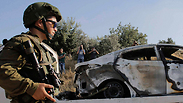
IDF soldier near burnt-out car
צילום: רויטרס
Kidnapping probe paints grim picture of police incompetence and a transmitting phone signal
Investigation into the night of abduction finds Gil-Ad's phone broadcast until after the boys' murder.
The investigation into the night of the kidnapping found that Gil-Ad Shaer's cell phone continued to broadcast a signal for nearly an hour and a half after the boys had been murdered.
The final signal received from the device was at 11:50 pm, near the village of Dura, where the burnt-out Hyundai was discovered – shortly after Shaer, Naftali Frenkel, and Eyal Yifrach were shot to death.
The investigation raised other frustrations related to the hesitant response of security forces to the emergency call: IDF forces had been rushed to an area mere kilometers from the scene of the kidnapping, following up on a report of an Israeli vehicle entering the village of Beit Fajjar.
At the same time, the IDF placed a military checkpoint south of Gush Etzion junction to search suspicious vehicles.
The kidnappers were able to flee along their escape route – driving a Hyundai i35 with an Israeli license plate – even though the IDF had raised the alert level in the area.
Related stories:
- Gil-Ad Shaer's mother: Police said the shots were blanks, we had hope
- Watch: Jewish rioters attack Arab youths in Jerusalem clashes
- Israelis meet in public spaces to mourn murdered teens
An analysis of the route taken by the killers showed that they began driving west after they picked up the boys from the hitchhiking stop, but pulled a U-turn – a move which alerted the boys to their intention and likely led to Shaer's call to the police. The kidnappers then continued driving east until they turned south to Halhul.
Investigators believe that killers crossed the town, driving on the main roadway with the murdered boys in the vehicle, between 10:30 pm and 11:30 pm – at a time when the town's residents filled cafes and restaurants to watch the opening game of the FIFA World Cup.
The kidnappers chose to hide the bodies in a shallow grave they had dug instead of one of the dozens of pits and caves in the area. The site was a small fenced-off plot, near a wooded area and agricultural land owned by a relative of one of the suspects.
Initially, the security establishment believed that three bodies had been thrown into a ditch, and the search focused on underground spaces and watering holes.
In the days leading up to the discovery of the bodies, security forces began searching in the Hazeka wadi which leads to the Telem settlement and separates between Beit Kahil and Halhul – it was in there was that glasses of one of the boys were found.
Last weekend the defense establishment received intelligence, likely from an accomplice to the abduction arrested by the Shin Bet, which reinforced the possibility that the boys had been buried, not thrown into a ditch.
The IDF then deployed Engineering Corps soldiers equipped with special scanners which began scanning the area of operations for buried bodies.
The difficulty in locating the bodies was partially attributed to where they had been buried. The kidnappers had picked a spot on the upper third of the terraced hill, out of sight of almost all the homes in the neighboring villages.
Aside from one structure located several hundred meters on the hill across from the location, no Palestinian could have seen the abductors bury the bodies that night.












